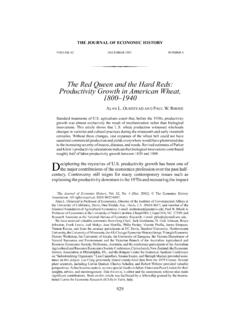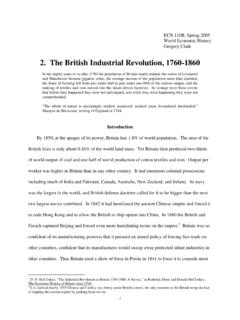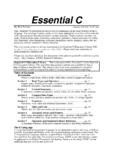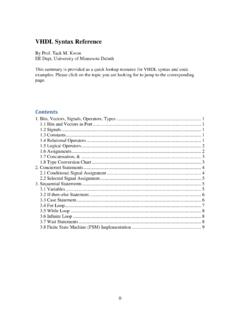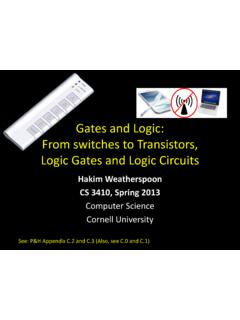Transcription of Lecture Notes on Dynamic Programming
1 Lecture Notes on Dynamic ProgrammingEconomics 200E, Professor Bergin, Spring 1998 Adapted from Lecture Notes of Kevin Salyer and from Stokey, Lucas and Prescott (1989)Outline1) A Typical Problem2) A Deterministic Finite Horizon ) Finding necessary ) A special ) Recursive solution3) A Deterministic Infinite Horizon ) Recursive ) Envelope ) A special ) An analytical ) Solution by ) Solution by iteration4) A Stochastic ) Introducing ) Our special case ) Finding Typical ProblemConsider the problem of optimal growth (Cass-Koopmans Model). Recall that in the Solowmodel the saving rate is imposed, and there is no representation of preferences. The optimalgrowth model adds preferences for households, and derives an optimal saving rate.
2 Utilityis maximized for the representative agent, given the technology that they re faced with. Thesocial planner s problem may be described as are summarized in the utility function:LES| c|'fc c4 Utility is assumed to be time-separable, that is, marginal utility of consumption today dependson today s consumption only. When households evaluate utility in the future, they discountit by a constant factorq cassuming consumption in the future is not valued as much asconsumption today. The objective is to maximize the present discounted value of future utility:"[|'fq|LES| Consider the technology. Output is produced using capital as the input:+|'sE&| We could also include labor as a factor. Note that we will use&|to represent capital availableat the beginning of period|; this is capital that was accumulated in the previous period|.]
3 Capital accumulation takes place through investment and saving. The law of motion for thecapital stock is:&|n '&|E B n |Where |is the amount of investment expenditure in a period toward building up the capitalstock for the following period. Depreciation is represented byB, and is the faction of existing2capital stock that decays away each period. We will initially assume there is 100% ' Investment expenditure and consumption expenditure must both come from current produc-tion, so the resource constraint for the social planner isS|n |'sE&| Combining this with the law of motion, we will be using as our budget constraint the following:S|n&|n 'sE&| With complete depreciation, the capital stock available in a period is derived completely fromsaving in the previous period.
4 So it is convenient to regard to the variable &|n simply as thelevel of saving in period|.The social planner problem may be written:4@ tS|c&|n "|'f"[|'fq|LdS|o(1)r | S|n&|n 'sE&| The social planner chooses consumption and saving in each period to maximize utility ofthe representative household. The solution is a sequence of variablesS|and&|n for all timeperiods|'fc c4. Finding an infinite sequence of variables is a big task. But fortunately,this problem has a recursive structure: the problem facing the social planner in each period isthe same as that he faced last period or next will characterize the solution by a function called a policy rule, which tells what theoptimal choice is as a function of the current state of the economy.]
5 In this case we will find arule for choosingS|and&|n as a function of&| Deterministic Finite Horizon necessary conditionsTo develop some intuition for the recursive nature of the problem, it is useful first to considera version of the problem for a finite horizon. Assume you die in a terminal consider using as a solution for the infinite horizon problem the solution we found for thefinite horizon problem, when we take a limiting case asA$ problem now may be written, where we substitute the constraint into the objectivefunction, and thereby eliminate the consumption as a variable to choose:4@ t&|n "|'fA[|'fq|LdsE&| &|n oLook at a section of the sum, which pertains to a generic period: nq|LEsE&| &|n nq|n LEsE&|n &|n2 n This includes all the appearances for&|n.]
6 Take a derivative with respect to&|n .q|L EsE&| &|n E nq|n L EsE&|n &|n2 s E&|n 'ffor| Aor cancelling extraqGL EsE&| &|n 'qL EsE&|n &|n2 s E&|n for| AThis is a necessary first order condition that applies to all periods prior to the terminal pe-riod. It describes the nature of the intertemporal decision I am making about whether I shouldconsume or save. It says that I will raise consumption until the point where if I raise con-sumption one more unit today, the gain in utility no longer exceeds the loss in utility tomorrow,because there is less capital and hence less output and consumption this condition does not apply to the terminal period. In the last period of your life, you4will not save for the future, but instead consume all that you produce:&An 'fThis is regarded as a boundary condition for the special caseThis problem can be solved analytically for a specific case with particular functional a log utility:LES| '*?
7 S|And a Cobb-Douglas production function:sE&| '&k|The first order condition above then becomes: &k| &|n 'q &k|n &|n2 k&k3 |n This is a second-order difference equation which is difficult to solve. We need to make it intoa fist-order difference equation by using a change in |'savings rate at time t'&|n &k|This turns out to be useful here, because the utility function here implies a constant savingrate, regardless of the level of first order condition then can be written: &k| 5| 'q&k|n 5|n k&k3 |n which may be simplified:5| 5|'kq 5|n 5or5|n ' nkq kq5|This is a relation between tomorrow s savings rate and today s savings rate. It is not asolution in itself, because it is a relation between optimal choices in different periods, not arule telling use the optimal choice as a function of the current state of the this relationship as a convex curve on a set of axes marked5|and5|n.
8 Graph also a45-degree line showing where5|'5|n . There are two points where the lines intersect. If theeconomy finds its way to one of these points, it will stay there. One such point is where thesaving rate is This is implausible, since it says all output is saved and none is other point where the saving rate iskq, a fraction of income less than one. Verify that5|'kqsatisfies the condition that the problem is constrained by the boundary condition, that saving is zero in theterminal period. In the graph, this means we start at the point5A'fand work our waybackward in time, to find out what the solution is for the current period. The graph suggestswe will converge to the point where5A'kq Provided that the terminal period when you dieis far enough in the future, this saving rate will be solution to the optimal saving problem forthe current recursivelyWe can perform this recursive operation explicitly.
9 Start at the boundary point:5A' for saving in the previous period,5A3 using the first order condition 'f' nkq kq5A3 so5A3 'kq nkq6 Now plug this back into the first order condition for the previous period:5A3 'kq nkq' nkq kq5A32which produces:5A32'kqE nkq nkqE nkq If we keep moving backwards:* 4A<"5|'* 4A<"A3|Sr' Ekq r nA3|Sr' Ekq r'kq*E kq *E kq 'kqSince this is the solution for the current period for when the terminal period is infinitelyfar away, it would be a natural conjecture that this is also the solution to an infinite horizonproblem, in which there is no terminal period. We will investigate this conjecture Deterministic Infinite Horizon FormulationLets consider again the infinite horizon problem:4@ tS|c&|n "|'f"[|'fq|LdS|o(problem 1)r | S|n&|n 'sE&| In general, we can t just find the solution to the infinite horizon problem by taking the limit ofthe finite-horizon solution asA$4.]
10 This is because we cannot assume we can interchangethe limit and the max operators:4@ * 4A<"A[|'fLES| 9'* 4A<"4@ A[|'fLES| So we will take a different approach, taking advantage of the problem s recursive nature,called Dynamic Programming . Although we stated the problem as choosing an infinite se-quences for consumption and saving, the problem that faces the household in period|'fcanbe viewed simply as a matter of choosing today s consumption and tomorrows beginning ofperiod capital. The rest can wait until that the solution we found for the finite-horizon problem suggested that the desiredlevel of saving is a function of the current capital stock. That is, the rule specifies the choiceas a function of the current state of the economy:&|n '}E&| Our goal in general will be to solve for such a function}, called a policy a function E&f , called the value function.]]

